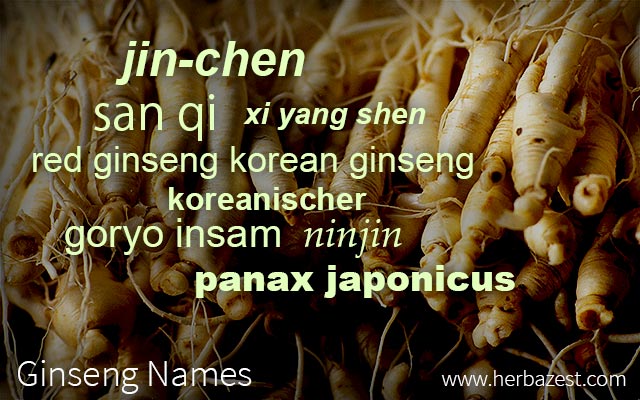Originally discovered in Asia 7,000 years ago, ginseng has developed a worldwide reputation for its healing and therapeutic properties. Today, ginseng is cultivated in Asia and North America and sold commercially to help with high blood pressure, diabetes, stimulating immunity, and improving mental performance.
Ginseng botanical name is Panax ginseng, being Panax a derivative of the Greek words pan (all) and akos (cure), used to designate ginseng as a cure-all herb. On the other hand, the term "ginseng" comes from the Chinese word renshen, which means "root of man" or "man root." This name describes the appearance of the ginseng root, which is fork shaped, resembling a human body, with a set of "two arms and two legs."
Ginseng Names Around the World
Multiple species and preparations go by the common name of ginseng. The two biggest commercial species are Panax ginseng (Korean and Chinese) and Panax quinquefolius (American or wild ginseng). Along with the specific ginseng scientific name, a color description may be added to the different types of Panax, which helps indicate the drying method used after harvesting. White ginseng, red ginseng, and black ginseng are all different forms of the same root depending on how they were dried, with white ginseng being sun-dried, red ginseng being steamed, and black ginseng going through a steam and dry process with nine cycles. As ginseng has become popular worldwide, it has developed even more versions of these names based on cultural and linguistic differences.
However, people are much more interested to know the names of ginseng in Chinese and Korean leanguages, mainly because most of ginseng products are made in Asia and they want to be sure they are buying the real thing.
These are some of the most popular ginseng names around the world:
Ginseng in Chinese language: Rénshēn, jin-chen, hong shen, xi yang shen, hua qi shen, san qi, tian qi; 人参
Ginseng in English language: Asian ginseng, Asiatic ginseng, black ginseng, Chinese ginseng, ginseng, Japanese ginseng, Korean ginseng, Manchurian ginseng, Oriental ginseng, red ginseng, true ginseng, white ginseng
Ginseng in German language: Koreanischer Ginseng, ginseng
Ginseng in Japanese language: Ninjin
Ginseng in Korean language: Goryo insam, sansam
Ginseng Latin names for different Panax species: Panax ginseng, Panax notoginseng, Panax pseudoginseng, Panax japonicus
American Ginseng Latin name: Panax quinquefolius
All of these examples are names of Panax ginseng and wild ginseng plants that share very similar benefits; however, a few other plants share the name without the same uses. It is worth noting that Siberian ginseng, or Eleutherococcus senticosus, is not a true ginseng. It is a completely different plant with its own unique set of benefits and side effects, not to be confused with American or Asian ginseng.
Whether referring to ginseng in Korean, Chinese, Japanese, or English, the many variations for ginseng common name all over the world show how essential this root has become to herbal medicine.
Sources
- Current Medicinal Chemistry, Current Evaluation of the Millennium Phytomedicine- Ginseng (I): Etymology, Pharmacognosy, Phytochemistry, Market and Regulations, 2009
- Ginseng and Ginseng Products 101: What are You Buying?, pp. 7, 14, 17, 21, 80
- Herbs and Natural Supplements, Volume 2: An Evidence-Based Guide, Volume 2, p. 439
- National Plant Germplasm System, Taxon: Panax ginseng C.A. Mey
- The Complete Guide to Natural Healing, p. 49
- University of Maryland Medical Center, Asian ginseng




